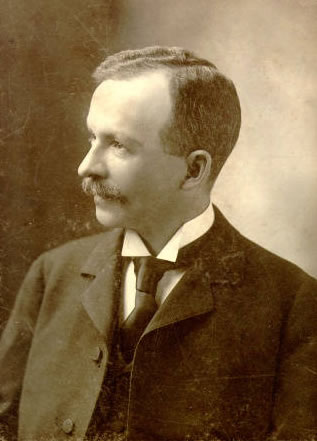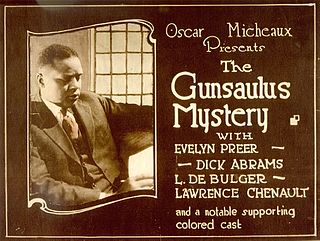Related Research Articles

Within Our Gates is a 1920 American silent film by the director Oscar Micheaux that portrays the contemporary racial situation in the United States during the early twentieth century, the years of Jim Crow, the revival of the Ku Klux Klan, the Great Migration of blacks to cities of the North and Midwest, and the emergence of the "New Negro". It was part of a genre called race films.

Charles Waddell Chesnutt was an American author, essayist, political activist and lawyer, best known for his novels and short stories exploring complex issues of racial and social identity in the post-Civil War South. Two of his books were adapted as silent films in 1926 and 1927 by the African-American director and producer Oscar Micheaux. Following the Civil Rights Movement during the 20th century, interest in the works of Chesnutt was revived. Several of his books were published in new editions, and he received formal recognition. A commemorative stamp was printed in 2008.

Oscar Devereaux Micheaux was an author, film director and independent producer of more than 44 films. Although the short-lived Lincoln Motion Picture Company was the first movie company owned and controlled by black filmmakers, Micheaux is regarded as the first major African-American feature filmmaker, a prominent producer of race films, and has been described as "the most successful African-American filmmaker of the first half of the 20th century". He produced both silent films and sound films.
In societies that regard some races or ethnic groups of people as dominant or superior and others as subordinate or inferior, hypodescent refers to the automatic assignment of children of a mixed union to the subordinate group. The opposite practice is hyperdescent, in which children are assigned to the race that is considered dominant or superior.
The tragic mulatto is a stereotypical fictional character that appeared in American literature during the 19th and 20th centuries, starting in 1837. The "tragic mulatto" is a stereotypical mixed-race person, who is assumed to be depressed, or even suicidal, because they fail to completely fit in the "white world" or the "black world". As such, the "tragic mulatto" is depicted as the victim of the society that is divided by race, where there is no place for one who is neither completely "black" nor "white".
Rhinelander v. Rhinelander was a divorce case between Kip Rhinelander and Alice Jones. Leonard "Kip" Rhinelander was an American socialite and a member of the socially prominent and wealthy New York City Rhinelander family. His marriage at the age of 21 to Alice Jones, a biracial woman who was a working-class daughter of English immigrants, made national headlines in 1924.
Gertrude Sanborn was an American journalist, short story writer, and novelist.

Lawrence Chenault was an American vaudeville performer and silent film actor. He appeared in approximately 24 films between years 1920 and 1934; most of his performances were in films directed by pioneering African-American filmmaker Oscar Micheaux. His brother, Jack Chenault, was also a film actor.
The Virgin of the Seminole is a 1922 race film directed, written and produced by Oscar Micheaux.

The Gunsaulus Mystery is a 1921 American silent race film directed, produced, and written by Oscar Micheaux. The film was inspired by events and figures in the 1913-1915 trial of Leo Frank for the murder of Mary Phagan. The film is now believed to be lost. Micheaux remade the film 1935 as Murder in Harlem.

A Daughter of the Congo is a 1930 race film directed, written and produced by Oscar Micheaux. The film is loosely based on the novel The American Cavalryman (1917), by African-American novelist and playwright Henry Francis Downing. It is considered a lost film.
Uncle Jasper's Will is a 1922 race film directed, produced and written by Oscar Micheaux. The film is a drama about the contents of a last will and testament left behind by an African-American sharecropper who was lynched after being falsely accused of the murder of a white plantation owner. The film was intended as a sequel to Micheaux’s landmark feature Within Our Gates (1920).

Veiled Aristocrats is a 1932 American Pre-Code race film written, directed, produced and distributed by Oscar Micheaux. The film deals with the theme of "passing" by mixed-race African Americans to avoid racial discrimination. It is a remake of The House Behind the Cedars (1927), based on a novel by the same name published in 1900 by Charles W. Chesnutt. Micheaux may have borrowed the new title from a 1923 novel by Gertrude Sanborn.
A Son of Satan is a 1924 silent race film directed, written, produced and distributed by Oscar Micheaux. The film follows the misadventures of a man who accepted a bet to spend a night in a haunted house. Micheaux shot the film in The Bronx, New York, and Roanoke, Virginia.

"The Wife of His Youth" is a short story by American author Charles W. Chesnutt, first published in July 1898. It later served as the title story of the collection The Wife of His Youth and Other Stories of the Color-Line. That book was first published in 1899, the same year Chesnutt published his short story collection The Conjure Woman.

The House Behind the Cedars is the first published novel by American author Charles W. Chesnutt. It was published in 1900 by Houghton, Mifflin and Company. The story occurs in the southern American states of North and South Carolina a few years following the American Civil War. Rena Walden, a young woman of mixed white and black ancestry, leaves home to join her brother, who has migrated to a new city, where he lives as a white man. Following her brother's lead, Rena begins living as a white woman. The secret of her identity leads to conflict when she falls in love with a white aristocrat who learns the truth of her heredity. The ensuing drama emphasizes themes of interracial relations and depicted the intricacies of racial identity in the American south.
The Symbol of the Unconquered is a 1920 silent "race film" drama produced, written and directed by Oscar Micheaux. It is Micheaux's fourth feature-length film and along with Within Our Gates is among his early surviving works. The Symbol of the Unconquered was made at Fort Lee, New Jersey, and released by Micheaux on November 29, 1920. A print of the film is extant at the Museum of Modern Art in New York. The film is based on the way perceptions of race shape human relationships.
The Virginia State Board of Censors was a government agency formed on August 1, 1922 for the purpose of reviewing and licensing films for approval to be screened in the state of Virginia. During the agency's existence its members examined over 52,000 films, over 2,000 of which required edits before approval was given; and another 157 films were rejected entirely, of which only 38 won subsequent approval. The board disbanded in 1968 following a series of U.S. Supreme Court rulings which overturned censorship statutes across the country.
Birthright is a 1924 silent film by American director Oscar Micheaux. Produced in 10 reels, it is adapted from Thomas Sigismund Stribling's novel of the same title (1922). The film is now lost.
Elcors "Shingzie" Howard was an actress in the U.S. She appeared in several Oscar Michaux films. She also worked for the Colored Players Film Corporation.
References
- ↑ "The House Behind the Cedars". silentera.com. Retrieved March 3, 2013.
- 1 2 3 4 5 6 7 8 J. Douglas Smith, Managing White Supremacy, pp. 101-104, UNC Press, 2002. ISBN 0-8078-5424-7
- 1 2 3 “Overview: The House Behind the Cedars", AllMovie, New York Times
- ↑ Whiteman, "Charles W. Chesnutt" Archived August 16, 2011, at the Wayback Machine , Berea University faculty
- ↑ Dan Moos, Outside America, University Press of New England, 2005, ISBN 1-58465-506-2
- ↑ “Headline to Headlights: Oscar Micheaux's Exploitation of the Rhinelander Case", The Western Journal of Black Studies, Fall 1998
- ↑ Bernard L. Peterson, Early Black American Playwrights and Dramatic Writers: A Biographical Directory and Catalog of Plays, Films, and Broadcasting Scripts, Hartford, Connecticut: Greenwood Publishing Group, 1990. ISBN 0-313-26621-2
- ↑ “Race Films Screening", University of Chicago Chronicle, January 12, 2002
- ↑ “Progressive Silent Film List: The House Behind the Cedars", SilentEra.com